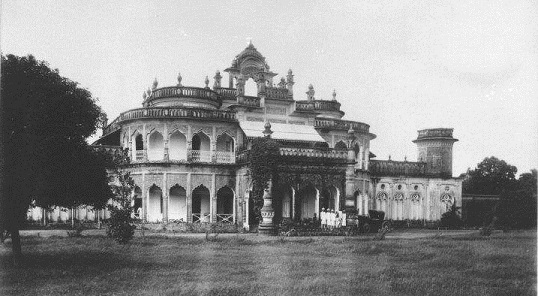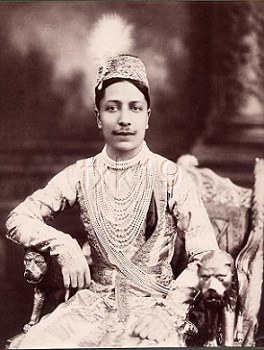Rampur City
(→=Unauthorised use of photograph in China) |
|||
| Line 92: | Line 92: | ||
=Members of the family= | =Members of the family= | ||
==Nawabzadi Mehrunnisa Khan== | ==Nawabzadi Mehrunnisa Khan== | ||
| − | ===Unauthorised use of photograph in China== | + | ===Unauthorised use of photograph in China=== |
[https://timesofindia.indiatimes.com/india/up-princess-photo-goes-off-menu-at-shanghai-eatery/articleshow/76377333.cms Nazar Abbas, UP 'princess' photo goes off menu at Shanghai eatery, June 15, 2020: ''The Times of India''] | [https://timesofindia.indiatimes.com/india/up-princess-photo-goes-off-menu-at-shanghai-eatery/articleshow/76377333.cms Nazar Abbas, UP 'princess' photo goes off menu at Shanghai eatery, June 15, 2020: ''The Times of India''] | ||
| Line 108: | Line 108: | ||
Nawab Kazim told TOI, "After the action taken by the Indian Ambassador in China, the owner of Masala Art has removed the pictures of Mehrunnisa Khan from the menu cards of all the six restaurants in Shanghai, and he has apologised”. | Nawab Kazim told TOI, "After the action taken by the Indian Ambassador in China, the owner of Masala Art has removed the pictures of Mehrunnisa Khan from the menu cards of all the six restaurants in Shanghai, and he has apologised”. | ||
| + | |||
| + | [[Category:India|RRAMPUR CITY | ||
| + | RAMPUR CITY]] | ||
| + | [[Category:Pages with broken file links|RAMPUR CITY]] | ||
| + | [[Category:Places|RRAMPUR CITY | ||
| + | RAMPUR CITY]] | ||
| + | [[Category:Princely dynasties|RRAMPUR CITY | ||
| + | RAMPUR CITY]] | ||
=See also= | =See also= | ||
Revision as of 11:00, 6 October 2020









Contents |
Rampur City
This section has been extracted from THE IMPERIAL GAZETTEER OF INDIA , 1908. OXFORD, AT THE CLARENDON PRESS. |
Note: National, provincial and district boundaries have changed considerably since 1908. Typically, old states, ‘divisions’ and districts have been broken into smaller units, and many tahsils upgraded to districts. Some units have since been renamed. Therefore, this article is being posted mainly for its historical value.
Capital of the State of Rampur, United Provinces, situated in 28 49' N. and 79 2' E., on the left bank of the Kosi or Kosilla, on a road from Moradabad to Bareilly and on the Oudh and Rohilkhand Railway, 851 miles by rail from Calcutta and 1,070 from Bombay, Population is increasing slowly but steadily. The numbers at the three enumerations were as follows : (1881) 74,250, (1891) 76,733, and (1901) 78,758. In 1901 the population included 58,870 Musalmans and 17,371 Hindus. Rampur first became of notice as the residence of Faiz-ullah Khan, younger son of All Muhammad. For a time it bore the name Mustafabad It is enclosed by a broad, dense, bamboo hedge, about six miles in circumference, which was formerly pierced by only eight openings and formed a strong defence. Within recent years dealings have been made in two places. In the centre of the city stands the new fort, surrounded by a wall 5,000 feet in circuit.
It is built entirely of brick and is entered by two lofty gateways. The interior of the fort is a large open space, containing palaces and other buildings. A fine library contains an exceptionally valuable collection of manuscripts. West of the fort are the public offices, in an impos- ing range of buildings completed in 1892. The large Jama Masjid was built by Nawab Kalb All Khan at a cost of 3 lakhs. Other buildings for the use of the Nawab and his family include the Khas Bagh palace, the Khusru Bagh palace, and commodious stables for horses, camels, and elephants. The chief public buildings are the jail, police station, high school, tahsili) and male and female dispensaries. Houses are maintained for the European officials outside the city, and the canton- ments he beyond these.
Municipal administration was introduced in 1890. Up to 1903 the only income raised by specific taxation consisted of a tax for watch and ward, which brought in about Rs. 4,000 or Rs 5,000. Octroi has now been introduced. In 1903-4 the expenditure was Rs. 61,000, including public works (Rs. 20,000), conservancy (Rs. 18,000), and lighting (Rs. 13,000). The city produces pottery, damask, sword-blades, and cutlery, and is the chief trading centre in the State. It is also the chief educational centre, and contains 43 schools with 2,254 pupils. The principal institutions are the high school, where English education is provided, a technical school with 100 pupils, and an Arabic college/ There are five girls' schools with 130 pupils.
2018: worst city to live in?
There are no city buses, no waste disposal site, the local hospital can’t handle emergencies, schools are without textbooks, and the power supply is erratic. Rampur’s residents have long said it is called a city just for the sake of it, and now the Centre has made it official.
“We stand vindicated. We have always said it can’t get worse than this elsewhere in India,” Lakshya Saxena, a 25-year-old sales executive, told TOI after Rampur finished last among 111 cities in the Ease of Living Index 2018 that was released by the ministry of housing and urban affairs on Monday.
Rampur’s 3.25 lakh residents dump about 165 tonnes, or 20 truckloads of garbage every day. Some of it is dumped in Ghatampur village nearby, and the rest rots on the streets as there is no waste management facility.
“We were promised that Rampur municipality will generate electricity from waste. We have garbage everywhere, but no electricity,” said Syed Amir Mian, an advocate. The city’s sewers overflow everywhere, even outside the district hospital.
Chief sanitation officer and food inspector TPS Verma blamed severe staff shortage. “According to a government order of 1991, there should be 28 sweepers for a population of 10,000. However, we have only 199 sweepers against the 355 permanent posts, and 170 against the 534 contractual posts. We have to outsource the cleaning in 21of 43 wards.”
The district hospital is working at half strength as well. There are 13 doctors against 27 sanctioned posts who see over 4,000 out-patients every day. In the women’s ward, two patients often share a bed. The hospital does not have specialists like cardiologist, neurologist, skin specialist and ENT, so, at times, “we have no option but to refer patients to medical colleges in Meerut and Aligarh,” chief medical superintendent Dr B M Nagar said. None of the hospitals has an MRI machine.
Education is a textbook case, too. At the Kasturba residential school in Loha, TOI found a student sweeping classrooms. “If sweepers are absent, students clean classrooms,” head teacher Yogita Rathore said. The adjoining primary school boasts English medium instruction but does not have electricity. It has two classrooms for 147 students, and no benches. Classes I and II, and IV and V have been merged while Class III students sit in the verandah. Textbooks are awaited.
With no buses, Rampur’s public transport is made up of tempos and autos — less than 50 each — and 350 e-rickshaws.
Outages of 5-6 hours are a daily affair. Power theft from overhead lines is also rampant, and the unpaid bills add up to Rs 35 crore. The electricity department is laying underground cables to stop power theft, but executive engineer Sachin Kumar Singh said some residents have been resisting this. “In the past six months, we have received over 10 cases of locals trying to stop underground cabling work.”
While chief development officer S K Singh refused to comment, district magistrate Mahendra Bahadur Singh said, “We will aim to be among the top 50 cities for next year’s appraisal.”
Members of the family
Nawabzadi Mehrunnisa Khan
Unauthorised use of photograph in China
Nazar Abbas, UP 'princess' photo goes off menu at Shanghai eatery, June 15, 2020: The Times of India

From: Nazar Abbas, UP 'princess' photo goes off menu at Shanghai eatery, June 15, 2020: The Times of India
RAMPUR: A restaurant in China's Shanghai has removed the photographs of a former Indian princess from its menu card after Indian Ambassador to that country Vikram Misri took up the matter following protests from her family in UP. Princess Nawabzadi Mehrunnisa Khan is the daughter of the last nawab of Rampur.
Misri pursued the matter after former UP minister and four-term MLA Nawab Kazim Ali, her nephew, sent a letter to India's consul general in Shanghai on June 11 saying that the Masala Art restaurant did not take permission from the erstwhile royal family or from Mehrunnisa to use her photo.
In the letter written to India's consul general to Shanghai Anil Kumar Rai on June 11, Ali said it was an "invasion of privacy". He wrote: "...Shri Rajesh Prabhakar, owner of Masala Art restaurant, Shanghai, is using the photograph of my aunt Nawabzadi Mehrunnisa Khan of Rampur in the menu cards of all his restaurants. This is being used in a derogatory manner without our permission. ...We are terribly distressed as this is a total invasion of our privacy".
He added, "For your information, Nawabzadi Mehrunnisa Khan is the daughter of the last nawab of Rampur state Nawab Syed Raza Ali Khan, who was the first ruler of undivided India to merge his state in the Union of India in May, 1949. Due to this gesture, half of Gandhi Ji's ashes were sent to Rampur from Delhi by the then PM Pandit Jawaharlal Nehru. She is also the sister of my father Nawab Syed Zulfquar Ali Khan, a six-term MP from Rampur." The action was swift. On June 12, Misri reverted and told Khan that the menus have been withdrawn.
Mehrunnisa was married to Rahim Khan who was the commander-in-chief of Pakistan Airforce during the 1971 war. While Khan is no more, Mehrunnisa, almost 90 and ailing, lives in Washington DC.
Nawab Kazim told TOI, "After the action taken by the Indian Ambassador in China, the owner of Masala Art has removed the pictures of Mehrunnisa Khan from the menu cards of all the six restaurants in Shanghai, and he has apologised”.
See also
Rampur City